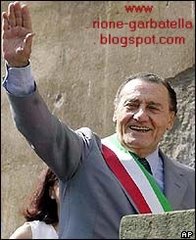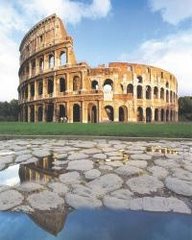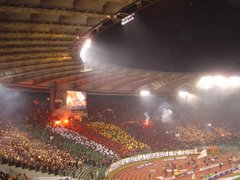Renaissance Rome
During the Middle Ages, the city of Rome was abandoned due to the transfer of the papal court to Avignon, in France. The absence of the pope thus caused an economic crisis that forced the population to abandon the city. This, reduced to poverty, soon became a mass of ruins where herds of sheep and cattle grazed. But after 1418, the year when Pope Martin V re-established the Papal See in Rome, the city began to be born again and, at the end of the 15th century, it returned to being the great capital it had once been.
This itinerary starts with the Vatican Museums, within which it is possible to visit the Sistine Chapel, one of the most famous and visited monuments in the world.
Ordered in the late 15th century by Pope Sixtus IV, from which it takes its name, the chapel is the most emblematic example of papal patronage during the Renaissance. It is decorated with extraordinary frescoes executed by Perugino, Ghirlandaio, Luca Signorelli, Botticelli and Cosimo Rosselli, who at the end of the 15th century were the most famous painters working between Tuscany and Umbria. Later the chapel, to be used by both the pope and the congregation, was adorned with the extraordinary paintings done by Michelangelo in the 16th century. The great artists - who was also of Tuscan origin - painted the frescoes of the vault between 1508 and 1512, and those of the altar wall, with the extremely famous Last Judgment, between 1534 and 1541. The approximately four hundred characters crowding the Judgment scene are almost all naked, and in some cases persons who were the artist's contemporaries are portrayed. Minos, with his sides encircled by a snake biting his testicles, has the features of Biagio da Cesena, a papal Master of Ceremonies, while in the skin of St. Sebastian, who was skinned alive, it is possible to recognise the face of Michelangelo. The nudes caused a great scandal at the time and, when Michelangelo was still alive, they were partly painted over with garments by Daniele da Volterra, earning him the nickname of "Il Braghettone" (the "breeches maker"). The restoration work to clean the frescoes of the Sistine Chapel was completed in 1999 and made it possible to rediscover the vivid original colours, darkened for so many years by soot.
From the Vatican Museums, where it is also possible to see Raphael's Stanze, painted between 1509 and 1512, and the Borgia Apartment, frescoed in the late 15th century by Pinturicchio, we can arrive in St. Peter's Square.
The square is dominated by the largest church in the world: St. Peter's Basilica. The dome was designed by Michelangelo, who also designed the plan of the Renaissance church, rebuilt over the early Christian one as ordered by papal architect Donato Bramante, who had the ancient basilica torn down.
For this reason Bramante was nicknamed "Mastro ruinante" ("ruining master"). By Michelangelo there is also the beautiful Pietà, kept in the first chapel of the right aisle. It is the only work actually signed by the great artist. It is said that the sculptor, angry because no one knew who had done the masterpiece, decided to engrave his name on the band encircling the Virgin's breast. Michelangelo also engraved his monogram "M" in the folds of the Virgin's right hand, the one turned towards the viewer.
From St. Peter's, by crossing the Ponte Vittorio Emanuele II, we can go for lunch at Lilli, a typical Roman trattoria, at Via Tor di Nona 26 (06 6861916). At Via del Governo Vecchio 28, on the other hand, is Da Giovanni, a very popular food store specialised in pizza with various fillings!
Near Piazza Navona is the beautiful church of Santa Maria della Pace, with a Baroque façade by Pietro da Cortona. In reality it was built on order from Sixtus IV, the same pope who had the Sistine Chapel, built, in the late 15th century.
Inside there are frescoes by Peruzzi and Raphael (the Sibyls). The cloister is an extraordinary example of Renaissance architecture, and is the first work completed in Rome by Bramante.
To plunge completely into the Renaissance atmosphere, it is sufficient to lose yourself among the alleys of the Parione quarter, between Piazza del Fico, Via di Parione, Via del Governo Vecchio, Via di Monte Giordano and Via dei Coronari, famous for its antique shops. Looking at the façades of the buildings is a real pleasure, often compounded by the amazement over the unexpected discovery of a lovely courtyard.
The areas around Via della Pace, Piazza del Fico and Via del Governo Vecchio come alive, in the late afternoon through to late at night, with crowds of people that make the quarter one of the city's liveliest. For eating or drinking there is a vast selection to choose from, although for a "Roman" style pizza we recommend Baffetto on Via del Governo Vecchio and Il corallo on the street of the same name. Also delightful is the restaurant Ciccia bomba at Via del Governo Vecchio 76 (06 68802108).
In Piazza Pasquino Piazza Pasquino there is the statue of Pasquino, the most famous "talking statue" in Rome.
For centuries the torso of the ancient statue has been used to post satirical writings, the so-called "pasquinades", written by anonymous citizens or famous poets such as Pietro Aretino and Gianbattista Marino.
There were at least six talking statues. Those that are still known are Madama Lucrezia in Piazza San Marco; Marforio in the courtyard of Palazzo Nuovo at the Capitol; the Facchino (the Porter) on Via Lata, Abbot Luigi in Piazza Vidoni, and the Baboon on Via del Babuino.
Crossing Corso Vittorio Emanuele, we arrive at the Regola quarter, where other Renaissance streets open out. Via di Monserrato, which takes its name from the Spanish sanctuary of Montserrat, was called in olden times Via di Corte Savella, after the prisons and tribunals under the jurisdiction of the Savelli family. Along the street, there are many buildings erected between the 15th and 16th centuries, including the House of Pietro Paolo della Zecca, Palazzo Incoronati (n. 152), Palazzo Ricci (n. 25) and the one at n. 117.
Used in the Renaissance by prostitutes, the building was restored in 1870 by the owner who, criticised for having wanted to modernise the façade too much, had the architrave engraved with the phrase "Trahit sua quemque voluptas" (Everyone is moved by his own pleasure), thus intending to claim his right to act freely. Via del Pellegrino is a section of the straight medieval street that connected the zone of the Porticus of Octavia with the Ponte Sant'Angelo.
Reorganised in the 15th century by Popes Sixtus IV and AlexanderVI, the street still has several façades of buildings painted in the 16th century (nos. 64-66). At no. 58 lived Vannozza Cattanei, the lover of Cardinal Rodrigo Borgia, later pope Alexander VI, from whom were born Lucretia and Cesare, called Valentino. At the end of the street, towards Campo de' Fiori, on the right there opens a closed alley leading into a very picturesque courtyard, the "Archetto degli Acetari", shown in numerous paintings and prints.
At Via Monserrato 107 we find Hollywood, a store specialised in videocassettes of quality films, with an extraordinary quantity of cassettes to rent or buy. And on Via del Pellegrino the Libreria del viaggiatore is the most well-supplied bookshop specialised in travel books in Rome.
Among the largest and most important palaces of the quarter are, in Piazza della Cancelleria the beautiful Palazzo della Cancelleria, built in the 15th century by Cardinal Raffaele Riario.
The titular of the church of San Lorenzo in Damaso and nephew of the late Pope Sixtus IV, Riario built his palace with money won in a dice game against Franceschetto Cybo, son of Pope Innocent VIII. The building, extraordinarily imposing for being the residence of a cardinal, was built on the basis of a design by an unknown architect. Today the plan is attributed to Andrea Bregno, probably helped by Donato Bramante, who conceived the elegant courtyard.
Campo de' Fiori is certainly one of the most characteristic squares in Rome, with its open-air market and the statue of Giordano Bruno in the centre. The Dominican philosopher was burned at the stake in Campo de' Fiori on 17 February 1600 because he was judged a heretic (he supported the heliocentric theory of Copernicus and Galileo, who were his friends). The statue was executed by Ettore Ferrari in 1887.
At no. 22 of the square, there is a baker's shop that is worth a stop. Its pizza, just out of the oven, is one of the best in Rome. In the evening Campo de' Fiori becomes a meeting place, especially for young people who go to the Vineria and the little restaurants of the zone. For lovers of Roman cooking, we point out Carbonara (06 6864783) and the Hosteria romanesca (06 6864024), which serves an excellent "amatriciana".
The most famous street of the quarter is undoubtedly Via Giulia which can be reached by crossing Piazza Farnese. The palace which has given the name to this great open-air drawing-room is the Palazzo Farnese, built by Antonio da Sangallo il Giovane for Cardinal Alessandro Farnese, who became pope in 1534 with the name of Paul III.
Finished by Michelangelo, who did the central window, the cornice and the third floor of the court, since 1871 the building has been the seat of the French Embassy. If the French so permit, it can be visited by reservation, calling 06 686011. Entry into the palace is a true privilege considering that, up to a short time ago, the ambassadors did not appreciate visits. Inside the building are the Galleria dei Carracci and the Sala dei Fasti Farnesiani, frescoed by Salviati.
Nicknamed "il Dado" (the Die) because of its shape, the palace has recently been restored. The cleaning of the façade brought out the original polychromy of the losenge-shaped bricks decorating the surface.
Via Giulia takes its name from Pope Julius II, who had it opened, after a plan by Bramante, in the early 1500s, in order to establish the seats of the palaces of power there.
However, the ambitious project was never carried through, even if work was begun on the construction of the tribunal of which it is still possible to see today, between Via del Cefalo and Via del Gonfalone, several large marble blocks, nicknamed by the Romans "the sofas of di Via Giulia", which formed the base of the façade. On via Giulia is the Cavalcavia dei Farnese, a large arch which creates a romantic view of the street.
It was constructed in 1603 to unite, by crossing the road, Palazzo Farnese with other buildings across from it. This part of the street was the side of several Roman festivals, including the "palio de barberi e cavalli" (competition of barbarians and horses) in 1638.
To cross the Tiber we go over the Ponte Sisto, the origins of which date from the 2nd century A.D.
The present-day bridge, which until 1999 underwent a major restructuring and reinforcement operation, was erected in the second half of the 16th century, over the foundations of the ancient one, by Pope Sixtus IV della Rovere, from whom it took its name. On the occasion of the Jubilee of 1475, the bridge was to connect the two banks of the river, allowing the Trastevere quarter to be directly connected with the rest of the city.
In Trastevere, from Piazza Trilussa, we arrive on Via della Lungara passing underneath the Porta Settimiana.
Constructed, in the 3rd century, as an arch honouring the emperor Septimus Severus, the gate was later incorporated into Aurelian's wall and enlarged in the 15th century. It owes its present appearance to Pope Pius VI.
At Via Santa Dorotea 19 it is believed that Fornarina, Raphael's lover, loved. The woman, also immortalised in the famous painting kept in the Galleria Nazionale d'Arte Antica of Palazzo Barberini, supposedly also lived in another house at Via del Governo Vecchio 48, as remembered by the inscription in the lobby. At Via di Porta Settimiana 8 there is Romolo (06 5818284), one of the most characteristic restaurants in Trastevere. With its internal garden, it was Trilussa's favourite eating place.
The Renaissance itinerary can only end with Villa Chigi, known as La Farnesina, at Via della Lungara 230.
An architectural masterpiece by Baldassarre Peruzzi, the suburban home was built in the early 16th century for the rich Sienese banker Agostino Chigi. Insied are frescoes by Peruzzi, Sebastiano del Piombo, Sodoma and Raphael. It is an extraordinary place which is an absolute must to visit.
The banquets organised by Agostino Chigi are famous for their pomp. At the end of a banquet in 1518, to the amazement and dismay of the guests, all the plates and gold tableware which had been used for the food were thrown into the Tiber. But Agostino Chigi's astuteness was such that numerous nets, arranged beforehand on the riverbed, made it possible to recover the valuable objects afterwards!
Along Via della Lungara is the Regina Coeli prison, founded in the late 19th century, whose name derives from the pre-existing church of Santa Maria Regina Coeli. It is said that there are no Romans "de Roma" who have not descended, at least once, "er gradino der Coeli", i.e. the steps leading into the prison.
To wind up the evening we can eat at La scala, a pleasant bistro where it is also possible to listen to live music, Via della Scala 60 (06 5803763).
Hours of museums and monuments: Vatican Museums and Sistine Chapel, Viale del Vaticano, hours 8.45 a.m.- 3.45 p.m., closed Sundays. Admission fee. Villa Farnesina alla Lungara, Via della Lungara 230, hours 9 a.m.- 1 p.m., closed Sundays. Admission free.












